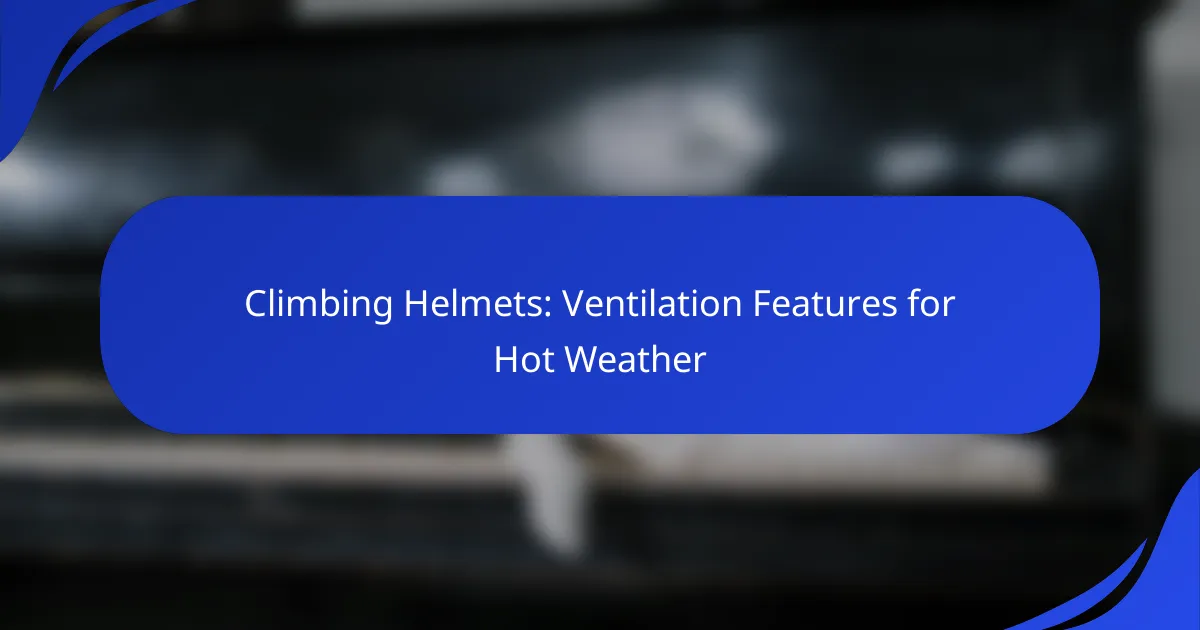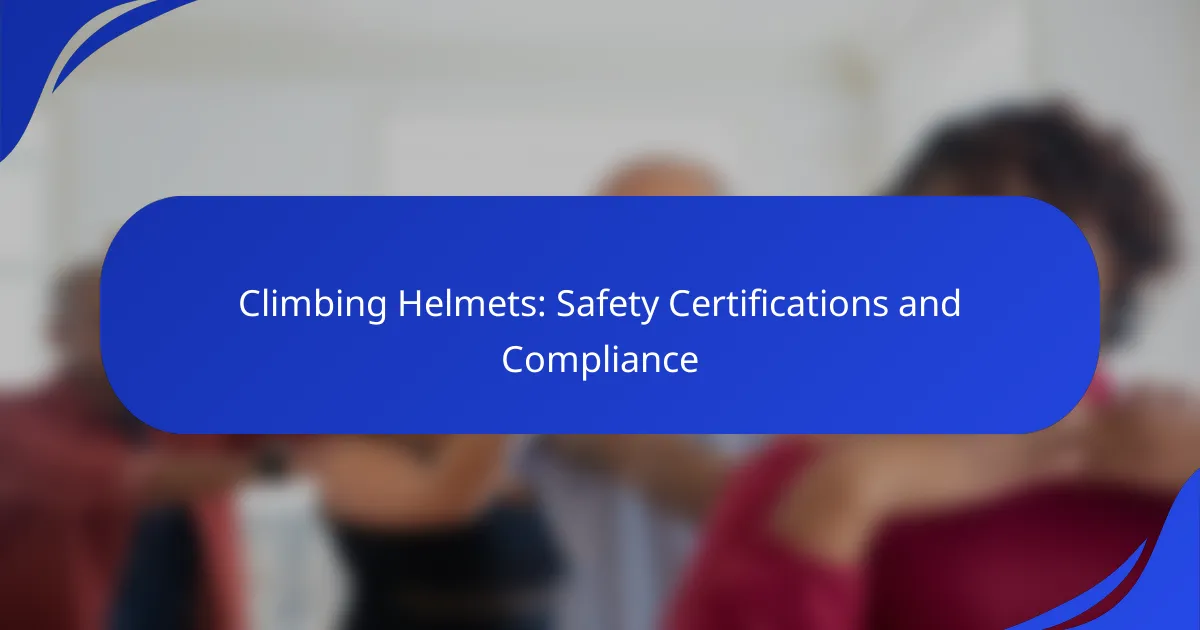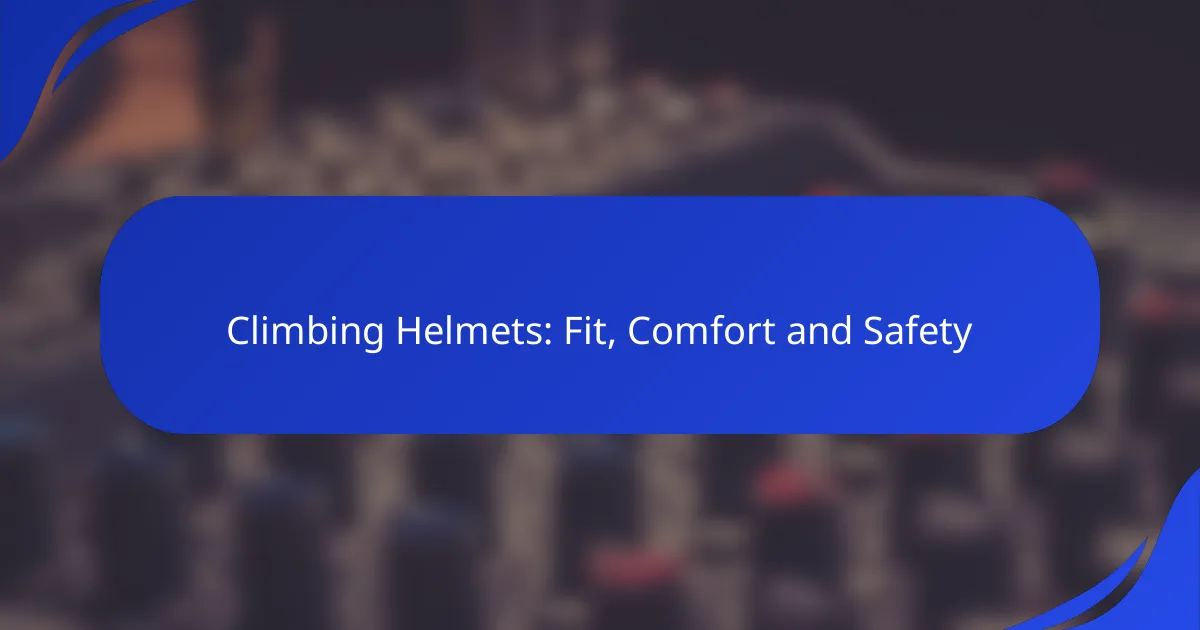When it comes to climbing, budget helmets offer a practical solution that balances safety, comfort, and affordability. These helmets meet essential safety standards like EN 12492 or UIAA, ensuring climbers are well-protected without overspending. While they may lack some advanced features of pricier models, key aspects such as impact resistance, fit, and secure chin straps remain a priority for effective protection on the rock face.

What are the best budget climbing helmets for safety?
The best budget climbing helmets prioritize safety without breaking the bank. Look for helmets that meet safety standards such as EN 12492 or UIAA, ensuring they provide adequate protection during climbing activities.
Petzl BOREO features
The Petzl BOREO is designed for versatility and durability, making it a popular choice among climbers. It combines a hard outer shell with an expanded polystyrene foam liner, providing excellent impact resistance.
This helmet includes adjustable ventilation, allowing for airflow during climbs, and a comfortable fit with its adjustable chin strap. Weighing around 300 grams, it’s lightweight yet robust, suitable for various climbing styles.
Mammut Skywalker 2 advantages
The Mammut Skywalker 2 offers a blend of comfort and safety, featuring a robust shell and a soft inner padding for a snug fit. Its design includes a headlamp holder, making it practical for night climbs.
This helmet is particularly noted for its excellent ventilation system, which helps keep climbers cool during strenuous activities. Weighing approximately 350 grams, it remains light enough for extended use without causing fatigue.
Black Diamond Half Dome specifications
The Black Diamond Half Dome is a classic choice known for its reliability and affordability. It features a durable polycarbonate shell and an EPS foam liner, meeting safety standards for climbing helmets.
With a weight of about 330 grams, it balances protection and comfort. The helmet includes a simple adjustment system for a secure fit and is compatible with various headlamps, enhancing its usability for climbers.

How do budget climbing helmets compare in comfort?
Budget climbing helmets can provide adequate comfort, but they often lack the advanced features found in higher-end models. Key factors affecting comfort include weight, padding, and fit, which can vary significantly among different brands and models.
Weight comparison of popular models
When comparing the weight of budget climbing helmets, most models typically range from 300 to 400 grams. Lighter helmets, around 300 grams, often prioritize comfort and ease of wear, making them suitable for long climbs. Heavier options may offer additional protection but can become cumbersome during extended use.
For example, the Black Diamond Half Dome weighs approximately 370 grams, while the Petzl BOREO is about 350 grams. Choosing a lighter helmet can enhance your climbing experience, especially on multi-pitch routes.
Padding and fit of Petzl BOREO
The Petzl BOREO features a combination of expanded polystyrene and a hard outer shell, providing both comfort and durability. Its padding is designed to conform to the shape of the head, ensuring a snug fit that minimizes movement during climbs.
Additionally, the BOREO includes adjustable straps for a customizable fit, which is crucial for comfort during long periods of wear. Users often report that the helmet’s design allows for good ventilation, further enhancing comfort in warm conditions.

What are the key safety features of budget climbing helmets?
Budget climbing helmets prioritize essential safety features such as impact resistance, proper fit, and secure chin straps. These elements work together to protect climbers from head injuries while remaining affordable.
Impact resistance ratings
Impact resistance ratings indicate how well a helmet can withstand sudden forces. Most budget climbing helmets meet the EN 12492 standard, which ensures they can handle impacts from falling objects or falls. Look for helmets that have been tested for both vertical and lateral impacts to ensure comprehensive protection.
When selecting a helmet, consider the materials used in construction. Polycarbonate and EPS foam are common in budget models, providing a good balance of weight and durability. Helmets with higher impact ratings typically offer better protection but may come at a slightly higher price.
Chin strap effectiveness
The effectiveness of a chin strap is crucial for helmet stability during climbing. A well-designed chin strap should be adjustable and secure, preventing the helmet from shifting or falling off during a fall or sudden movement. Look for helmets with a four-point harness system for optimal fit and security.
Check that the chin strap is made from durable materials and has a quick-release mechanism. This feature allows for easy removal in emergencies. Always ensure the strap fits snugly under your chin without causing discomfort, as a loose strap can compromise safety.

How to choose the right budget climbing helmet?
Choosing the right budget climbing helmet involves balancing safety, comfort, and fit. Look for helmets that meet safety standards while providing a snug fit and lightweight materials to ensure comfort during climbs.
Size and fit considerations
Proper size and fit are crucial for a climbing helmet’s effectiveness. A helmet should sit level on your head, with the front edge just above your eyebrows and the straps snug but not uncomfortable. Many helmets come in adjustable sizes or have multiple shell sizes to accommodate various head shapes.
To find the right fit, measure your head circumference and refer to the manufacturer’s sizing chart. It’s advisable to try on helmets in-store if possible, as this allows you to assess comfort and stability during movement.
Material durability
Durability in budget climbing helmets typically comes from materials like polycarbonate or ABS plastic, which provide a good balance of weight and strength. These materials can withstand impacts and are often resistant to scratches and environmental wear.
While budget helmets may not feature advanced materials like carbon fiber, many still offer sufficient protection for recreational climbing. Look for helmets with a hard outer shell and an inner foam layer to absorb shock effectively. Regularly inspect your helmet for signs of wear, such as cracks or dents, and replace it if any damage is found.

What are the best practices for maintaining climbing helmets?
Maintaining climbing helmets is crucial for ensuring their longevity and safety performance. Regular cleaning, proper storage, and periodic inspections can help keep your helmet in optimal condition.
Cleaning guidelines
To clean your climbing helmet, use mild soap and water. Avoid harsh chemicals or solvents, as these can degrade the materials. Gently scrub with a soft cloth or sponge, focusing on areas that collect dirt and sweat.
After cleaning, rinse thoroughly and allow the helmet to air dry completely before storing. Regular cleaning after each climbing session can prevent buildup and extend the life of the helmet.
Storage recommendations
Store your climbing helmet in a cool, dry place away from direct sunlight and extreme temperatures. Avoid leaving it in your car or near heat sources, as excessive heat can weaken the materials.
Using a dedicated storage bag can protect your helmet from scratches and impacts. Ensure the helmet is not compressed or placed under heavy items, which can deform its shape and compromise safety features.

What are the latest trends in climbing helmet technology?
The latest trends in climbing helmet technology focus on enhancing safety, comfort, and functionality. Innovations in materials and the integration of smart technology are leading to helmets that are lighter, more durable, and equipped with features that improve the climbing experience.
Innovations in lightweight materials
Recent advancements in lightweight materials have significantly reduced the weight of climbing helmets while maintaining high safety standards. Materials such as expanded polystyrene (EPS) and polycarbonate shells are commonly used, providing excellent impact resistance without adding bulk.
Climbers should consider helmets that utilize these modern materials, as they enhance comfort during long climbs. A lightweight helmet can weigh as little as 200-300 grams, making it easier to wear for extended periods without fatigue.
Integration of smart technology
Smart technology is becoming increasingly prevalent in climbing helmets, offering features like built-in communication systems, sensors for impact detection, and even integrated lights for visibility. These innovations can enhance safety by allowing climbers to stay connected and informed about their surroundings.
When choosing a helmet with smart technology, consider the battery life and ease of use. Some models may offer features that are beneficial for specific climbing environments, such as adjustable ventilation or emergency alerts. However, ensure that the added technology does not compromise the helmet’s primary function of protection.

How do budget climbing helmets perform in different environments?
Budget climbing helmets can be effective in various environments, but their performance often depends on the specific conditions and materials used. While they may not offer the same level of protection as high-end models, many budget options still meet essential safety standards and provide adequate comfort for recreational climbers.
Performance in cold weather
In cold weather, budget climbing helmets can perform adequately if they are designed with insulation and windproof materials. Look for helmets that feature a snug fit to minimize heat loss and have ventilation systems that can be adjusted to prevent excessive cold air from entering.
Consider helmets with a thermal lining or those made from materials that retain warmth. Avoid models that are overly ventilated, as they can lead to discomfort in frigid conditions. Always check for compatibility with winter gear, such as thicker hats or hoods, to ensure a proper fit.










